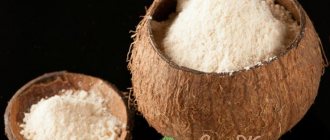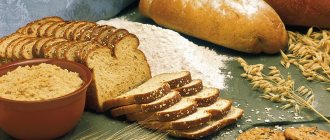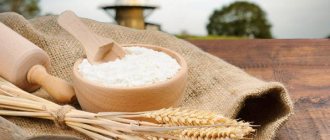What is grinding?
Flour, obtained from the same raw material, but using different processing methods, differs in its grinding:
- Fine grinding - such a product is the result of cleansing the grain from the shell, bran and aleurone layer. It is quickly digestible due to the significant amount of carbohydrates in the composition.
- Medium grind – this type of flour contains fiber from the grain shell. Use is limited.
- Coarse Grind (Whole Wheat Flour) – Similar to ground grain. The product has all the components of the original raw materials. It is most suitable and useful for use with diabetes and a healthy diet.
Approximate composition of flour:
- starch (from 50 to 90% depending on the variety);
- proteins (from 14 to 45%) – wheat has low levels, soybeans have the highest;
- lipids – up to 4%;
- fiber – dietary fiber;
- B-series vitamins;
- retinol;
- tocopherol;
- enzymes;
- minerals.
Wheat flour
Several varieties are made from wheat. The highest grade is characterized by low fiber content, the smallest particle size and the absence of grain shells. This product has a high calorie content (334 kcal) and significant glycemic index numbers (85). These indicators classify premium wheat flour as a product whose limitation is an important part of the diet of diabetics.
Premium wheat-based product is an enemy for diabetics
Indicators of other varieties:
- The first is that the particle size is slightly larger, calorie content – 329 kcal, GI 85.
- Second - size indicators are within 0.2 mm, calorie content - 324 kcal.
- Coarse grains – particles up to 0.5 mm, peeled, have a small amount of fiber.
- Wallpaper flour - up to 0.6 mm, unrefined grains are used, so the amount of vitamins, microelements and fiber is significantly higher than previous representatives.
- Whole grain flour - ground unprocessed grains of raw materials, is most useful for both healthy and sick people.
Important! In the diet of type 1 diabetics, the use of whole grain flour is allowed, but not often. In type 2 of the disease, it is better to completely abandon dishes based on wheat flour, since glucose-lowering drugs cannot accurately “block” the amount of carbohydrates supplied, unlike insulin.
Oat flour
Among all the raw materials used to produce oatmeal, oats have the lowest level of carbohydrates (58%). In addition, the grains contain beta-glucans, which lower blood sugar levels and help eliminate excess cholesterol, as well as B-vitamins and microelements (zinc, iron, selenium, magnesium).
Adding oat-based products to the diet can reduce the body's need for insulin, and a significant amount of fiber helps normalize the gastrointestinal tract. The glycemic index is in the average range - 45 units.
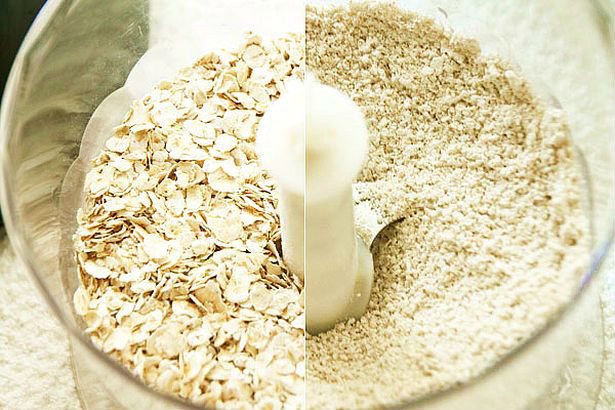
Oatmeal is a product of milling flakes
Possible oatmeal-based dishes for diabetics:
- oat cookies;
- pancakes with maple syrup and nuts;
- pies with sweet and sour apples and oranges.
Buckwheat oatmeal
Buckwheat flour (glycemic index is 50, calorie content is 353 kcal) is a dietary product that allows you to cleanse the body of toxins and waste. Beneficial properties of the constituent substances:
Pancakes made from rye flour for diabetics
- B vitamins normalize the functioning of the central and peripheral nervous system;
- nicotinic acid removes excess cholesterol and normalizes blood circulation;
- copper is involved in cell growth and differentiation, strengthens the body's defenses;
- manganese supports the functioning of the thyroid gland, normalizes glycemic levels, and allows the absorption of a number of vitamins;
- zinc restores the condition of the skin, hair, nails;
- essential acids provide the needs of energy mechanisms;
- folic acid (especially important during pregnancy) promotes normal fetal development and prevents the occurrence of neural tube abnormalities;
- iron helps increase hemoglobin levels.
Important! We can conclude that the product should be included in the diet of patients with diabetes and people who follow healthy eating rules.
Harm of soy flour
Despite the many beneficial properties for the human body, eating soy flour has its contraindications. The isoflavones contained in soy flour are substitutes for female sex hormones, which have a positive effect on the female reproductive system, but negatively affect the development of the fetal brain during pregnancy, increasing the risk of miscarriage. In addition, research by scientists has revealed a relationship between excessive consumption of soy products and menstrual irregularities in women of reproductive age.
Abuse of products that contain soy flour can cause cerebrovascular accidents, provoke the onset of Alzheimer's disease, and accelerate the aging process of the body. The harm of soy flour also extends to the endocrine system, causing disturbances in the human immune system, nervous and reproductive systems.
Excessive consumption of soy flour products is not recommended for children under 3 years of age - the product can provoke thyroid diseases and allergic reactions.
Corn oatmeal
The product has a borderline glycemic index of 70, but due to its composition and many beneficial properties it should be part of the diet of both healthy and sick people. It has high levels of fiber, which has a beneficial effect on the gastrointestinal tract and digestive processes.
Significant amounts of thiamine contribute to the normal course of nervous processes and improve blood supply to the brain. A corn-based product removes excess cholesterol, accelerates the regeneration of cells and tissues, and enhances muscle growth (against the background of significant physical activity).
Rye product
Rye oatmeal (glycemic index – 40, calorie content – 298 kcal) is the most desirable variety for making various types of flour products. This primarily applies to people prone to hyperglycemia. The wallpaper variety contains the greatest amount of nutrients, which is obtained from unrefined rye grains.

A rye-based product is a storehouse of vital vitamins and microelements
Rye flour is used for baking bread, but the content of minerals and vitamins is three times higher than that of wheat, and the amount of fiber is higher than that of barley and buckwheat. The composition includes essential substances:
- phosphorus;
- calcium;
- potassium;
- copper;
- magnesium;
- iron;
- B vitamins.
Making at home
It is difficult to find ready-made almond flour in regular grocery stores. Therefore, it can be prepared at home. A distinctive feature of this flour is its consistency. The homemade product turns out similar to porridge without any signs of dry powder.
The recipe is quite simple. To do this you will need: nuts, a coffee grinder (blender), and a container for soaking the nuts.
- Pre-soak the almonds in warm water for 30-40 minutes.
- Then dry in the oven.
- For a more pronounced almond flavor, it is recommended to fry the nut kernels in a dry frying pan.
- Then grind using a coffee grinder (blender).
- Place in an airtight container.
If you wish, you can not peel the nuts, then you will get whole flour, which is more beneficial for digestion.
It is important to remember that self-made flour is stored for a short time (no more than 3 days), it is better to use it immediately and not store it for future use.
Flaxseed flour
The glycemic index of flaxseed meal has 35 units, which classifies it as a permissible product. The calorie content is also low - 270 kcal, which is important when using this type of flour for obesity.
Flaxseed is made from flax seed after its oil is extracted by cold pressing. The product has the following beneficial properties:
- normalizes metabolic processes;
- stimulates the functionality of the gastrointestinal tract;
- prevents pathologies of the heart and blood vessels;
- normalizes glycemia and cholesterol levels;
- binds toxic substances and removes them from the body;
- has an anti-cancer effect.
Pea based flour
The GI of the product is low - 35, calorie content - 298 kcal. Pea flour has the ability to reduce the glycemic indicators of other foods when consumed simultaneously. Normalizes metabolic processes, prevents the growth and spread of tumor cells.

Pea oatmeal is a gluten-free product
The product reduces the quantitative indicators of cholesterol in the blood, is used for diseases of the endocrine system, and protects against the development of vitamin deficiency.
Important! Pea flour is good for making soups, sauces and gravies, pancakes, flatbreads, pancakes, donuts, main courses based on meat, vegetables and mushrooms.
Applications of soy flour
Soy flour is widely used in the food industry: it reduces the need for additional raw materials (and, consequently, the cost of production), the loss of product weight during heat treatment, while maintaining its quality at an appropriate level.
Soy flour is used in the production of sausages, breakfast cereals, cookies, processed foods, bread, pasta, cereals, and also as a replacement for skim milk powder and some substances in whole milk.
Amaranth flour
Amaranth is a herbaceous plant that has small flowers, native to Mexico. The seeds of this plant are edible and are successfully used in cooking. Amaranth flour is a good substitute for those crushed grains that have high GI values. Its EE index is only 25 units, calorie content is 357 kcal.
Properties of amaranth flour:
- has a large amount of calcium;
- has virtually no fat;
- contains substances that have an antitumor effect;
- Regular consumption of the product allows you to remove excess cholesterol and return blood pressure to normal;
- strengthens the body's defenses;
- allowed for those who cannot tolerate gluten (it is not included);
- considered a powerful antioxidant;
- Helps maintain hormonal balance.
Uses of almond flour
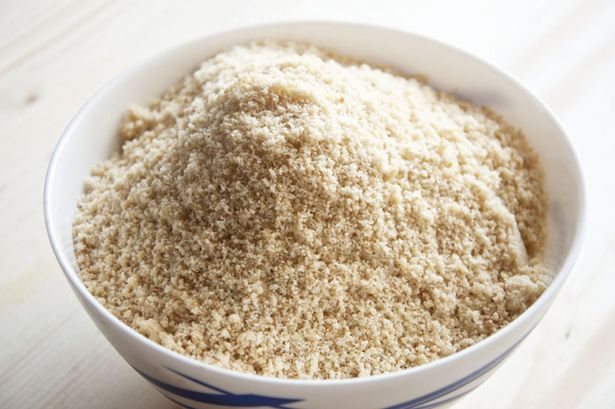
Almond flour is the most common flour used in confectionery. Baking made from this product turns out to be unusually fluffy and tasty; it is also distinguished by a subtle sweet aroma. In many ways, the benefits of almond flour in cooking are explained by its high hygroscopicity - the ability to effectively absorb and then retain liquid. Buns and other flour and confectionery products with such flour are especially juicy for this reason. Baked goods remain fresh for a long time and do not go stale. Nowadays very fashionable cakes – macaroons – are very popular. Almond flour is used in their preparation - the product gives the sweets a delicious nutty taste and divine smell. You can also use it to bake any dough, make nut cream, and sweets. In Mediterranean cuisine, almond flour is chosen not only for dessert dishes, but also for first courses, second courses, and sauces. Many people add it to porridges, puddings, casseroles - after all, this product easily changes the consistency of the product, making it thicker, more nutritious and, of course, tastier. The aroma of almonds, sweet and slightly milky, makes recipes festive and special.
Rice product
Rice flour has one of the highest GI values - 95. This makes it prohibited for diabetics and obese people. The calorie content of the product is 366 kcal.
Rice flour contains all B vitamins, tocopherol, macro- and microelements (iron, zinc, selenium, molybdenum and manganese). The benefits of the product are based on the complete composition of essential amino acids that are necessary for the normal functioning of the human body. In addition, this flour is gluten-free.
A product based on rice raw materials can be used to prepare pancakes, cakes, and a variety of sweets. This flour is not suitable for baking bread; for this purpose it is used in combination with wheat flour.
Calorie content Soy flour. Chemical composition and nutritional value.
Nutritional value and chemical composition of “Soy flour”.
The table shows the nutritional content (calories, proteins, fats, carbohydrates, vitamins and minerals) per 100 grams of edible portion.
| Nutrient | Quantity | Norm** | % of the norm in 100 g | % of the norm in 100 kcal | 100% normal |
| Calorie content | 434 kcal | 1684 kcal | 25.8% | 5.9% | 388 g |
| Squirrels | 40 g | 76 g | 52.6% | 12.1% | 190 g |
| Fats | 15 g | 56 g | 26.8% | 6.2% | 373 g |
| Carbohydrates | 33 g | 219 g | 15.1% | 3.5% | 664 g |
| Alimentary fiber | 4.5 g | 20 g | 22.5% | 5.2% | 444 g |
| Water | 5.16 g | 2273 g | 0.2% | 44050 g | |
| Ash | 4.46 g | ~ | |||
| Vitamins | |||||
| Vitamin A, RE | 6 mcg | 900 mcg | 0.7% | 0.2% | 15000 g |
| beta carotene | 0.072 mg | 5 mg | 1.4% | 0.3% | 6944 g |
| Vitamin B1, thiamine | 0.581 mg | 1.5 mg | 38.7% | 8.9% | 258 g |
| Vitamin B2, riboflavin | 1.16 mg | 1.8 mg | 64.4% | 14.8% | 155 g |
| Vitamin B4, choline | 190.6 mg | 500 mg | 38.1% | 8.8% | 262 g |
| Vitamin B5, pantothenic | 1.59 mg | 5 mg | 31.8% | 7.3% | 314 g |
| Vitamin B6, pyridoxine | 0.461 mg | 2 mg | 23.1% | 5.3% | 434 g |
| Vitamin B9, folates | 345 mcg | 400 mcg | 86.3% | 19.9% | 116 g |
| Vitamin E, alpha tocopherol, TE | 1.95 mg | 15 mg | 13% | 3% | 769 g |
| Vitamin K, phylloquinone | 70 mcg | 120 mcg | 58.3% | 13.4% | 171 g |
| Vitamin RR, NE | 4.32 mg | 20 mg | 21.6% | 5% | 463 g |
| Macronutrients | |||||
| Potassium, K | 2515 mg | 2500 mg | 100.6% | 23.2% | 99 g |
| Calcium, Ca | 206 mg | 1000 mg | 20.6% | 4.7% | 485 g |
| Magnesium, Mg | 429 mg | 400 mg | 107.3% | 24.7% | 93 g |
| Sodium, Na | 13 mg | 1300 mg | 1% | 0.2% | 10000 g |
| Sera, S | 378.1 mg | 1000 mg | 37.8% | 8.7% | 264 g |
| Phosphorus, Ph | 494 mg | 800 mg | 61.8% | 14.2% | 162 g |
| Microelements | |||||
| Iron, Fe | 6.37 mg | 18 mg | 35.4% | 8.2% | 283 g |
| Manganese, Mn | 2.275 mg | 2 mg | 113.8% | 26.2% | 88 g |
| Copper, Cu | 2920 mcg | 1000 mcg | 292% | 67.3% | 34 g |
| Selenium, Se | 7.5 mcg | 55 mcg | 13.6% | 3.1% | 733 g |
| Zinc, Zn | 3.92 mg | 12 mg | 32.7% | 7.5% | 306 g |
| Digestible carbohydrates | |||||
| Mono- and disaccharides (sugars) | 7.5 g | max 100 g | |||
| Essential amino acids | |||||
| Arginine* | 2.679 g | ~ | |||
| Valin | 1.724 g | ~ | |||
| Histidine* | 0.931 g | ~ | |||
| Isoleucine | 1.675 g | ~ | |||
| Leucine | 2.812 g | ~ | |||
| Lysine | 2.298 g | ~ | |||
| Methionine | 0.466 g | ~ | |||
| Threonine | 1.5 g | ~ | |||
| Tryptophan | 0.502 g | ~ | |||
| Phenylalanine | 1.802 g | ~ | |||
| Nonessential amino acids | |||||
| Alanin | 1.627 g | ~ | |||
| Aspartic acid | 4.342 g | ~ | |||
| Glycine | 1.597 g | ~ | |||
| Glutamic acid | 6.689 g | ~ | |||
| Proline | 2.02 g | ~ | |||
| Serin | 2.002 g | ~ | |||
| Tyrosine | 1.306 g | ~ | |||
| Cysteine | 0.556 g | ~ | |||
| Saturated fatty acids | |||||
| Saturated fatty acids | 2.987 g | max 18.7 g | |||
| 14:0 Miristinovaya | 0.057 g | ~ | |||
| 16:0 Palmitinaya | 2.192 g | ~ | |||
| 18:0 Stearic | 0.737 g | ~ | |||
| Monounsaturated fatty acids | 4.561 g | min 16.8 g | 27.1% | 6.2% | |
| 16:1 Palmitoleic | 0.057 g | ~ | |||
| 18:1 Oleic (omega-9) | 4.504 g | ~ | |||
| Polyunsaturated fatty acids | 11.657 g | from 11.2 to 20.6 g | 100% | 23% | |
| 18:2 Linolevaya | 10.28 g | ~ | |||
| 18:3 Linolenic | 1.378 g | ~ | |||
| Omega-3 fatty acids | 1.378 g | from 0.9 to 3.7 g | 100% | 23% | |
| Omega-6 fatty acids | 10.28 g | from 4.7 to 16.8 g | 100% | 23% |
The energy value of soy flour is 434 kcal.
Primary Source: Created in the application by the user. Read more.
** This table shows the average levels of vitamins and minerals for an adult. If you want to know the norms taking into account your gender, age and other factors, then use the “My Healthy Diet” application.




